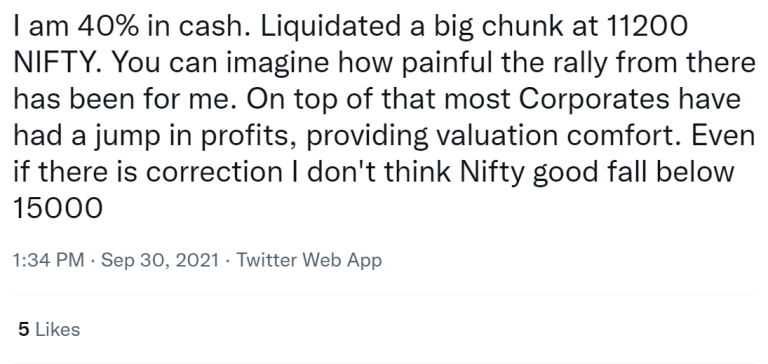One common mistake most investors do when investing directly in the stock market is – taking decisions based on Nifty or Sensex levels.
If Nifty is high – they avoid buying stocks until there is a correction in Nifty.
Now ask yourself this question: Has there even been a time in the last 18 months (April 2020 to October 2021) when Nifty hasn’t felt like it is too high?
The non-stop rise from 7500 level in March 2020 last year, has made people so uncomfortable that every rise feels like it could be the top. It almost feels like the market could crash anytime.
In a bull market:
- The price is always uncomfortable.
- Every rise makes people want to sell.
- And once they hit that sell button, it doesn’t give an opportunity to buy it back.
There are many who sold their entire portfolio when Nifty was at 10,000 to 14,000. The thinking was, Nifty has gone back to where it was before the Covid crash – it cannot rise further.
Several businesses were still struggling due to lockdowns and other Covid-related issues.
“How much more can the market rise?”
Today, Nifty is at 18,000. That’s 50% rise at Nifty level. Many stocks have doubled or tripled from there.
There are thousands of investors like this.
Here are some tweets without revealing their identity:


The second image is a tweet from a guy who runs a financial website. He ended up selling his entire portfolio in August last year.
This article is not to defame anyone, it is just to inform our readers that riding / staying invested in a bull market is not easy at all. Even for those who have been in the market for a long time.
Imagine the situation on the ground. Every business is closed, but market is rising. It’s very difficult to understand why the market is rising.
The reason is actually simple. The market does not care about the past. The market is forward looking, it will price-in what could or will happen in the next 2 years.
What if you sold?
If someone sold all their stocks when Nifty was at 12000, how and when will they enter back?
What if we only get 5-10% corrections and the bull market continues for the next 2-3 years?
Remember, crashes don’t happen as often as we think they do.
- There was a large 50-55% crash in 2008.
- And we had a quick correction of close to 40% in 2020 – which only lasted 2 months.
In between there will be smaller corrections, but a large crash requires an unexpected global event. And those events don’t happen as often as we think they do.
If Nifty has to go back to 12,000 levels, it has to now correct by more than 30%.
If Nifty has to go back to 7500, it has to crash 60% and that did not even happen in 2008.
The solution?
India still has huge potential for growth in the next 10 or even 20 years. The stock prices you see on screen today in 2021, even after such a huge bull market – will look cheap (small) when you see them in the year 2030.
Hundreds of companies will still end up creating huge wealth for investors.
Be stock specific. There will always be opportunities in stocks.
For example, at the time of writing this article, the tyre sector has undergone a long time correction.
The same applies to a select few automobile companies, along with auto ancillary and battery companies.
The cement sector after a long upward rise, has now started its correction which could last a few weeks or months.
When one sector gets overvalued, money from institutional and other big investors searches for value. The money moves from a sector which has gone up a lot, to sectors which have been consolidating.
Some call this ‘sector rotation’ which is also common in a bull market. If you find value in some of these sectors, and believe they have potential for growth over the next 5-10 years – there is no reason why you should not invest even at today’s prices.
Conclusion
Stock prices of March 2020 are now history. We might never ever go back to those levels ever again. The market crash was triggered by an unexpected global pandemic.
It’s time to forget those prices and look at opportunities in the current market.
Even though we were in a roaring bull market for the last 18 months, India’s most valuable company Reliance Industries was stagnant for 12 months.
Between July 2020 to end of July 2021, the stock price of Reliance consolidated between 1900 to 2100. This was an opportunity, after which, the stock shot up.
If you had bought Reliance between 1900-2100, you would still be sitting with FD-beating gains of more than 20%.
Focus on stocks, avoid looking at indices like Nifty or Sensex. Think long term.

Leave a Comment